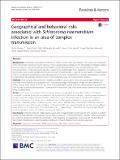| dc.contributor.author | Angelo, Teckla | |
| dc.contributor.author | Buza, Joram | |
| dc.contributor.author | Kinung’hi, Safari | |
| dc.contributor.author | Kariuki, Henry | |
| dc.contributor.author | Mwanga, Joseph | |
| dc.contributor.author | Munisi, David | |
| dc.contributor.author | Wilson, Shona | |
| dc.date.accessioned | 2019-10-10T06:35:25Z | |
| dc.date.available | 2019-10-10T06:35:25Z | |
| dc.date.issued | 2018 | |
| dc.identifier.uri | https://doi.org/10.1186/s13071-018-3064-5 | |
| dc.identifier.uri | http://dspace.nm-aist.ac.tz/handle/123456789/476 | |
| dc.description | Research Article published by Parasites & Vectors | en_US |
| dc.description.abstract | Background: Schistosoma haematobium infection in endemic areas varies depending on the nature and complexity
of the transmission networks present. Studies of micro-geographical transmission of S. haematobium infection indicate
that discrepancy in prevalence between households is associated with diverse water contact behaviors and
transmission that is restricted to particular sites harboring snail intermediate hosts. Detection of variations in the
transmission sources with complex transmission networks of water bodies is required for optimization of malacological
control. Longitudinal parasitological and malacological surveys were conducted to investigate geographical variations
in transmission of urogenital schistosomiasis in Ikingwamanoti village, Shinyanga District, Tanzania.
Methods: Urine samples were collected at baseline and follow-up time points from 282 school-aged children and
examined microscopically for the presence of S. haematobium eggs. Malacological surveys involved collection of
Bulinus nasutus every month from 30 sites. Snails were examined for patent infections. Global positioning system was
used to map household distances from S. haematobium transmission sites, while water contact behavior was assessed
using a questionnaire.
Results: Schistosoma haematobium infection was observed to be prevalent among older children (12–14 years)
compared to younger groups prior to treatment, but no significant difference in infection prevalence was observed at
one-year. Boys were highly infected than girls at both time points. No spatial influence was observed between
children’s infection and the distance from child’s residence to the nearby snail habitats nor was any significant
association observed between children’s reported water contact behavior with S. haematobium infection. However,
malacological surveys with cercarial shedding combined with GPS data detected significant variation among different
water sources in the transmission of S. haematobium with children living in households near to ponds with high B.
nasutus populations having the highest prevalence of infection.
Conclusions: Interaction between malacological surveys with cercarial shedding combined with GPSmapping in endemic
settings can help detection of transmission sources even in areas with complex transmission networks. Subsequent studies
are needed to determine whether the combination of GPS mapping and parasitology screens can aid the detection of
transmission hotspots across varied transmission settings to enhance schistosomiasis control programmes. | en_US |
| dc.language.iso | en | en_US |
| dc.publisher | Parasites & Vectors | en_US |
| dc.subject | Urogenital schistosomiasis | en_US |
| dc.subject | Malacological surveys | en_US |
| dc.subject | Water contact behavior | en_US |
| dc.title | Geographical and behavioral risks associated with Schistosoma haematobium infection in an area of complex transmission | en_US |
| dc.type | Article | en_US |

